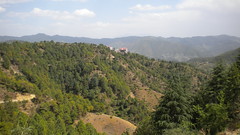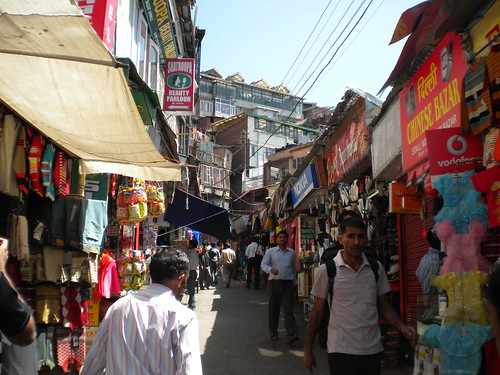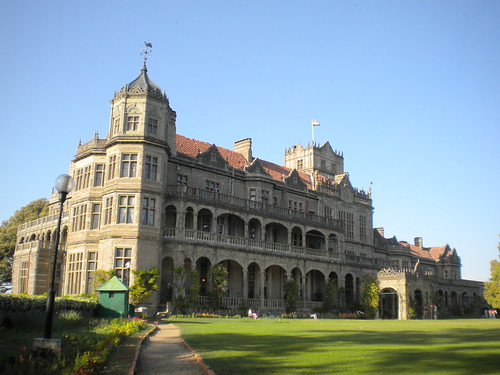
Shimla, British Raj’s Summer Capital
Yesterday morning, we took a Kandhaghat-bound bus from Chail Bazaar (about 35kms) and then a cab from there to Shogi, which is about 14kms before Shimla on National Highway 22. Shogi is listed in one of the guidebooks as a quiet, tranquil place to rejuvenate with lovely views of the Himalayan foothills. It was also recommended as a great place to stay while exploring Shimla. Since we weren’t sure if it would be easy to do day trips to Shimla from here, especially because we don’t have a car, we decided to stay for only one night before pushing off to Shimla.
There are just three things to do in Shogi: visit the Tara Devi temple (some 4kms away), visit the  local bazaar and simply walk around. Since we weren’t too keen on seeing a temple, we opted to just walk around and check the bazaar out. So yesterday afternoon, guided by the friendly Mr. Aggarwal, owner of Sunrise Villa (where we were staying for the day), we walked up to Shogi’s railway station (about a kilometer away) and down, via some steep steps, to the local bazaar. It turned out to be just a string of utility stores on either side of the national highway that runs through the village on to Shimla. We walked around a bit and found a Bhojanalaya for a quick lunch. It was good and rather cheap at just Rs.80 for a Dal Fry, Palak Paneer, Tandoori Rotis and a Mountain Dew .
local bazaar and simply walk around. Since we weren’t too keen on seeing a temple, we opted to just walk around and check the bazaar out. So yesterday afternoon, guided by the friendly Mr. Aggarwal, owner of Sunrise Villa (where we were staying for the day), we walked up to Shogi’s railway station (about a kilometer away) and down, via some steep steps, to the local bazaar. It turned out to be just a string of utility stores on either side of the national highway that runs through the village on to Shimla. We walked around a bit and found a Bhojanalaya for a quick lunch. It was good and rather cheap at just Rs.80 for a Dal Fry, Palak Paneer, Tandoori Rotis and a Mountain Dew .
With nothing else to do in Shogi, we packed our bags today morning and were all set to head to Shimla. But as we ate breakfast with Mrs. Aggarwal for company and told her of our plans, she couldn’t fathom why we would want to stay in noisy, congested, expensive Shimla, when it’s quite easy to simply do a day-trip from Shogi by taking a bus to there and back. We pondered over this and felt that she was absolutely right; after all the national highway thru which all the buses ply, is just a kilometer away in the bazaar. Moreover our stay in Sunrise Villa was relatively cheap and very comfortable; it would surely not be the same in Shimla. So we decided to stay back .
Since Shogi and Shimla lie on the same national highway and are just 14kms apart, there are plenty  of buses that ply between them. We walked to the bazaar and found a Shimla-bound bus almost immediately. The ride was just about half an hour long and it dropped us right at the foot of Shimla’s famed Mall Road. What we didn’t anticipate, though, was the steep climb up to it . We passed through, what is called the Lower Bazaar, which is where the locals shop for everything under the sun. It was a narrow, congested lane with tons of shops and street vendors – all quite colorful! But it was a hard climb as well. We were very relieved when we finally got onto Mall Road!
of buses that ply between them. We walked to the bazaar and found a Shimla-bound bus almost immediately. The ride was just about half an hour long and it dropped us right at the foot of Shimla’s famed Mall Road. What we didn’t anticipate, though, was the steep climb up to it . We passed through, what is called the Lower Bazaar, which is where the locals shop for everything under the sun. It was a narrow, congested lane with tons of shops and street vendors – all quite colorful! But it was a hard climb as well. We were very relieved when we finally got onto Mall Road!
Mall Rd, Shimla’s main street, is a pedestrian-only zone, making it an interesting area to explore.  The street is lined with stores and back in the day, was considered to be a chic place to shop at. Today, it contains just a hotchpotch of tourist-centric stores, which don’t look very inviting. At the center of it is Scandal Point, which is so called because of the scandalous attempt by the Maharaja of Patiala to kidnap the daughter of the then Viceroy LOL. From this point, a wide promenade slopes slightly uphill to the east and is locally known as The Ridge. It’s really a lovely, open space and a great place for people-watching . I wish they had developed it like the town squares of Europe, which are bordered by cafes and shops. Here there are just 2 restaurants and some vendors offering horse-rides and selling toys for kids. The place was packed with people, especially youngsters who seemed to be loitering around in groups. There were also quite a few kids returning from school in smart uniforms – we, Bombayites have always been envious of the blazer-clad students of the north !
The street is lined with stores and back in the day, was considered to be a chic place to shop at. Today, it contains just a hotchpotch of tourist-centric stores, which don’t look very inviting. At the center of it is Scandal Point, which is so called because of the scandalous attempt by the Maharaja of Patiala to kidnap the daughter of the then Viceroy LOL. From this point, a wide promenade slopes slightly uphill to the east and is locally known as The Ridge. It’s really a lovely, open space and a great place for people-watching . I wish they had developed it like the town squares of Europe, which are bordered by cafes and shops. Here there are just 2 restaurants and some vendors offering horse-rides and selling toys for kids. The place was packed with people, especially youngsters who seemed to be loitering around in groups. There were also quite a few kids returning from school in smart uniforms – we, Bombayites have always been envious of the blazer-clad students of the north !
At the east end of The Ridge is the lovely Christ Church. Built in 1846 for a cost of about Rs.50,0000,  it is a lovely cream colored structured with a tall bell tower and red roof. The main entrance was closed but we could enter through a side door. After removing our shoes, as directed by a sign near the door, we entered the beautiful prayer hall. It has tall, vaulted ceilings with wooden beams and lovely chandeliers. There were large stained-glass windows behind the main altar and to the right of the hall. Along the walls were memorial plaques in memory of the many British personnel or their family members who died in Shimla; sadly, many of them were of young men in their twenties who seemed to have died at some war or the other .
it is a lovely cream colored structured with a tall bell tower and red roof. The main entrance was closed but we could enter through a side door. After removing our shoes, as directed by a sign near the door, we entered the beautiful prayer hall. It has tall, vaulted ceilings with wooden beams and lovely chandeliers. There were large stained-glass windows behind the main altar and to the right of the hall. Along the walls were memorial plaques in memory of the many British personnel or their family members who died in Shimla; sadly, many of them were of young men in their twenties who seemed to have died at some war or the other .
To the left of the church is an uphill sloping road called the Jhaku road. We had read that 2kms up this road is a Hanuman temple, which is worth visiting. After having walked so much over the past few days, we were quite confident of the 2kms that lay ahead. However, an ominous sign at the base of the road got me worried ! It categorized the fitness level of those climbing the hill depending on their age group (below 30, 30 to 50, 50 to 70 and above 70) and the amount of time taken to get to the top. The fitness levels were Absolutely Fit, Fit and Needs Improvement . I realized that this could only mean that the climb uphill was not an easy feat. We checked our watches and set off with determination; this was a challenge we couldn’t take lightly !
The climb up Jhaku Road to the Hanuman Temple is unbelievably steep! We’ve never climbed up anything like this before. Forgetting all about the time, we stopped for a break, after every 100meters or so, breathing hard. At one point I wasn’t even sure if I would make it up all the way! But we kept going hoping that the torture would end soon. Throughout the walk we could see monkeys sitting around idly in the woods. However, as we neared the top, more and more of them started showing up along the sides. And suddenly Madhu saw a monkey sneak up behind a young man ahead of us and rifle through his pockets! It was shocking! And just as we were recovering from this sight, a monkey jumped on to the shoulders of another youth and stole his spectacles! The guy was absolutely distraught. Madhu and I hid our sunglasses in our daypack and quietly slid past, keeping an eye out for more thieving monkeys. Later when we met the lad at the temple, he said that he had eventually managed to get his glasses back by tempting the monkey with food stuff that he threw at it .
The Jhaku temple is a simple structure with a lovely ambiance within. After climbing the final steep steps that lead up to it, we removed our shoes and placed them in a small room provided by the temple authorities in order to keep them safely away from the monkeys . Inside the temple, the walls are completely lined and covered with garlanded pictures of Lord Rama and Lord Hanuman. The priest offered us some Prasad and on the prodding of a fellow visitor, spoke about the significance of the temple. It is believed, according to Ramayana, that when Lord Hanuman flew to the Himalayas in search of Sanjeevini, a medicinal herb to heal the wounds of ailing Laxmana, he stopped at this very spot to rest.
And, yes, we had made it to the top in less than 45minutes, putting us in the Absolutely Fit category for 30 to 50 year olds LOL.
After grabbing some lunch of Chinese food (Indian version) we walked over to Gaiety Theatre,  which is on The Ridge, halfway between Christ Church and Scandal Point. Built in 1887, it was once a focal point of Shimla’s cultural scene. Today, we found an exhibition of paintings and sculptures by Delhi’s prestigious Lalit Kala Academy (fine arts institute) on display. The exhibition hall within the theater complex is absolutely gorgeous and the art on display was equally stunning. We were very impressed by some of the work and had a great time browsing thru them. Across from the exhibition hall was a smaller hall where many artists sat painting. We loved looking at their ‘in-progress’ work and felt quite envious of their talent! One finished, abstract piece in colors of grey, black and white caught our attention the most and we stood staring at it for several seconds. Later we walked thru one of the side entrances of the theater only to find it occupied by some people, who seemed to be in the middle of some conference. So we couldn’t really explore it properly nor take any pictures as that would surely disturb them. We peeked about a bit from the outside and then left.
which is on The Ridge, halfway between Christ Church and Scandal Point. Built in 1887, it was once a focal point of Shimla’s cultural scene. Today, we found an exhibition of paintings and sculptures by Delhi’s prestigious Lalit Kala Academy (fine arts institute) on display. The exhibition hall within the theater complex is absolutely gorgeous and the art on display was equally stunning. We were very impressed by some of the work and had a great time browsing thru them. Across from the exhibition hall was a smaller hall where many artists sat painting. We loved looking at their ‘in-progress’ work and felt quite envious of their talent! One finished, abstract piece in colors of grey, black and white caught our attention the most and we stood staring at it for several seconds. Later we walked thru one of the side entrances of the theater only to find it occupied by some people, who seemed to be in the middle of some conference. So we couldn’t really explore it properly nor take any pictures as that would surely disturb them. We peeked about a bit from the outside and then left.
From here we walked west on Mall Rd heading towards Viceregal Lodge, one of Shimla’s landmark structures. However, since it was a few kilometers away from the town center, the guidebooks didn’t mark it on the city maps. So we had to ask around and found that people didn’t really know where it was. Then we realized that the Viceregal Lodge is today known as the Indian Institute of Advanced Studies (IIAS) and this the local crowd knew of. They told us to keep walking west on Mall road for about 3kms and we did just that, passing interesting buildings such as the Vidhan Sabha and the posh Oberoi Cecil Hotel. The walk was long but it took us away from the crazy, congested town center and towards the greener, calmer areas of Shimla; it was lovely. When we finally got to the entrance of the institute, it was just before 4:30pm and a sign posted there made us realize that we had just about half an hour to explore the place before it closes for the day. So we hurried up the 500meters uphill, which led to the lovely structure that was formerly known as the Viceregal Lodge.
Situated atop Observatory Hill, the Viceregal Lodge was built in 1888 as a summer residence for the  British viceroys of India. It is one of the grandest British-era buildings in Shimla and we loved it at first sight. As we hurriedly bought entrance tickets, we were told that the last tour of the day had just begun within the main entrance hall of the building and that we could join it immediately. We practically ran up to the entrance and found a group of about 20 people surrounding a young lady, who seemed to be leading the tour. The tour had started at 4:30pm; we were 5minutes late.
British viceroys of India. It is one of the grandest British-era buildings in Shimla and we loved it at first sight. As we hurriedly bought entrance tickets, we were told that the last tour of the day had just begun within the main entrance hall of the building and that we could join it immediately. We practically ran up to the entrance and found a group of about 20 people surrounding a young lady, who seemed to be leading the tour. The tour had started at 4:30pm; we were 5minutes late.
The entrance hall of IIAS is absolutely stunning with Burmese teak wood adorning the walls and 2-storey balconies overlooking it. The tour leader informed us that after independence, this building was used as a summer residence for the presidents of India. However, in 1965, the then president of India, Dr. Radhakrishnan, handed it over to the IIAS. It has been beautifully maintained since then by the institute, which accepts only PHD-holders as students and that too after careful screening by the Ministry of HRD ! The tour leader showed us the old, 19th century electrical switches that are still in use within the building. We were then guided to a large conference room where the Indian National Congress had met in 1945 to make the most important decision regarding India’s independence: the partition of Pakistan from India! This room is large and elegant with a lovely walnut-wood ceiling. Outside the doors that lead out to the lawns, is an ornate bell, which was used by the viceroys to sound an alarm in case of emergencies. An exhibition of pictures of India’s pre-independence leaders as they visited the Viceregal Lodge was displayed in an adjoining hall. This was the last room that we could visit within the building, after which we were guided out to the lovely, surrounding lawns. We spent a lot of time here just walking around and taking pictures of the beautiful building from different angles.
Our day-trip to Shimla ended here and we walked back to the bus stand, finding one to Shogi almost instantly. In spite of everything negative that we’ve heard and read about Shimla, we kind of enjoyed our day here. The city center is definitely congested and kitschy but it’s also interesting and worth checking out. The outer, greener areas of Shimla have a quiet elegance and we really enjoyed walking thru it. There’s still more to see of it, though¦


No comments yet.